Last updated: March 19, 2021
Article
Experimental reintroduction of state-endangered beach pea (Lathyrus japonicus) to Indiana Dunes National Lakeshore
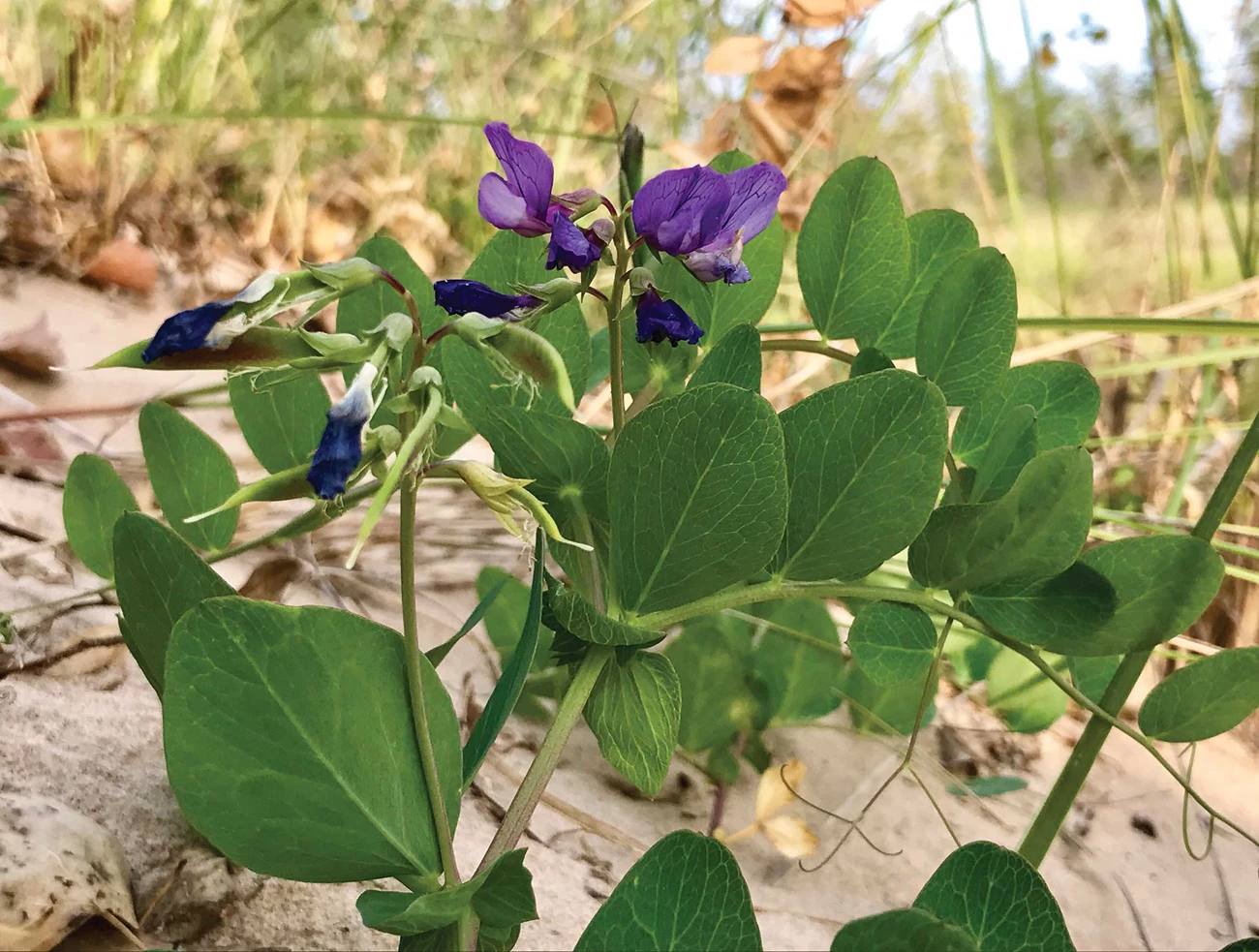
Photo courtesy of Jo Ann Dollard
Beach pea (Lathyrus japonicus), a state-listed endangered plant in Indiana, was once a common foredune plant along the coast of Indiana Dunes National Lakeshore (fig. 1). Although it is found throughout the Great Lakes, the species is extirpated at the park because of anthropogenic pressures. These include high recreational use, destruction of sand dunes by industry, construction of seawalls that obstruct the natural sand movement, and urban development.
The national lakeshore is located along the southern border of Lake Michigan, approximately 80 km (50 mi) east of Chicago, Illinois. The park is composed of 29 km (18 mi) of coastline and 5,754 ha (14,218 ac) of dune system, and a large interdunal wetland exists behind the coastal beach.
The park stands out as having the highest plant diversity of northeastern national parks (Hatfield et al. 2013; USGS, N. B. Pavlovic, research ecologist, e-mail, 20 February 2018). In the early 20th century, Henry Cowles of the University of Chicago conducted pioneering research on plant community succession. Cowles Bog, named in his honor, is now a large wetland restoration site located near the coast.
In preparation for reintroduction of beach pea to Indiana Dunes National Lakeshore, we visited several beach pea populations along the coasts of Lakes Michigan and Superior, including the only natural population of the species in Indiana and others at Sleeping Bear Dunes and Pictured Rocks National Lakeshores in Michigan, and Apostle Islands National Lakeshore in Wisconsin (fig. 2). We considered the beach pea populations at Sleeping Bear Dunes, Pictured Rock, and Apostle Islands to be reference populations, because they were not subject to human-caused environmental stresses or shoreline disturbance. At these locations we collected information on beach pea habitat, reproduction, and common plant associates.
In addition, we conducted a trial experiment in 2007 to evaluate possible reintroduction sites at Indiana Dunes and to understand the effects of winter storms on transplants. That same year, we built a raised wooden structure near the park’s plant nursery, filled it with sand, and planted it with juvenile beach pea plants. The purpose of this was to provide seeds for future reintroduction work. We initiated the experimental beach pea reintroduction in 2008.
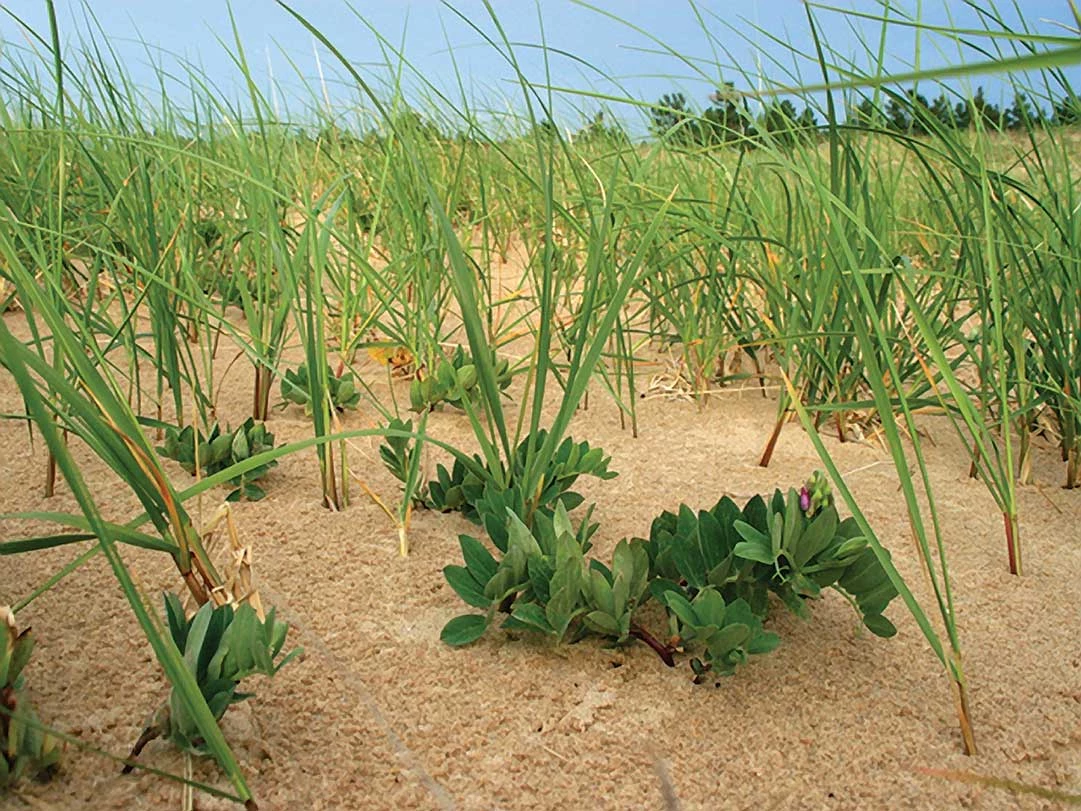
Photo courtesy of Jo Ann Dollard
Beach pea habitat and biology
Beach pea is an early successional plant that grows commonly on the foredune nearest the lake or ocean. Its geographic range is along the coast of North America, Europe, and Asia. The plant is now endangered in Indiana and extirpated in Illinois.
Beach pea is a glabrous (smooth) perennial with procumbent stems (that sprawl along the ground) (Brightmore and White 1963). Its leaves are slightly fleshy and pinnate (i.e., divided into leaflets), ending with a long tendril that acts as an anchor. Flowers are compact and erect unbranched stems, which bloom from June through August. From late summer to early fall, the plants form brown seedpods.
Beach pea often grows in open areas near the crests of foredunes, in locations with low wave energy. I have also observed that it grows in the coastal strand near water. We have found some populations growing in blowouts (interior areas where the foredune has been breached), farther back from the lake.
Although beach pea is a prolific seeder, the majority of plant reproduction is vegetative through rhizomes (underground stems) that can grow 1 m long (3.3 ft). Once seeds are dispersed by the plant, conditions have to be almost perfect for germination. New plants from seed might develop in a low, wet depression in the sand or around wrack (plant debris), which would provide the seed a moist environment.
In the more remote, less visited sites (Michigan and Wisconsin) along the first foredune, I observed marram grass (Ammophila breviligulata, see fig. 2) and Pitcher’s thistle (Cirsium pitcheri) as common plant associates of beach pea. At Indiana Dunes each of these plants has been impacted by anthropogenic stressors. Beach pea is now extirpated and is state endangered. The only population in Indiana is located at a nearby natural preserve. Pitcher’s thistle is federally listed, with small populations scattered in blowouts throughout the park. And marram grass, which still commonly grows along the foredunes, has been impacted by trampling in high recreational areas.
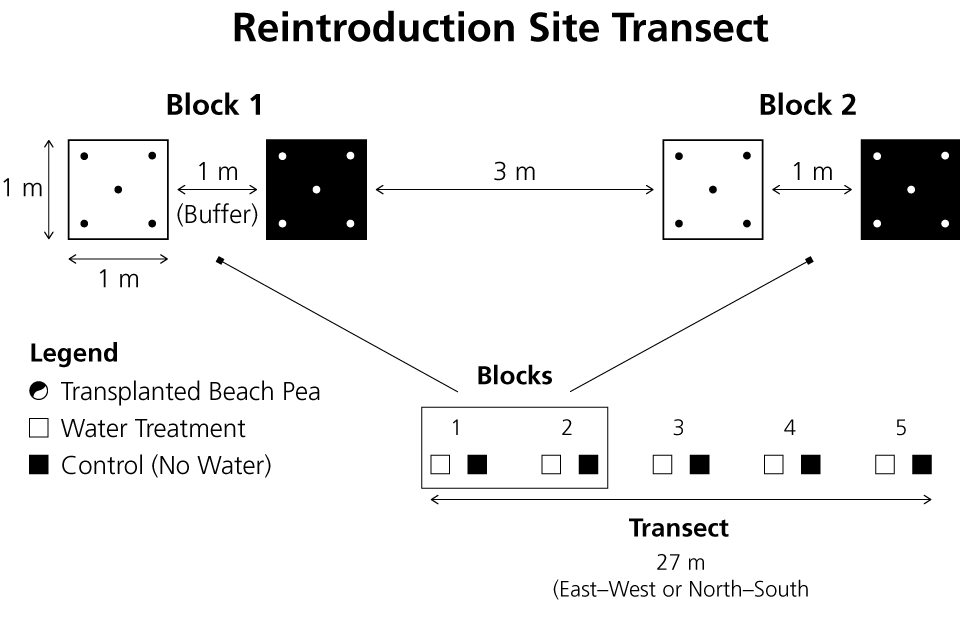
Experimental reintroduction
Horticultural methods
We collected seeds for the experimental reintroduction in 2007 from a population along the coast of Lake Michigan in Indiana. We placed the seeds in a cool location for drying and then cleaned them before storing them for winter. Seeds were cold stratified for three months. Then, the following spring (March 2008), we nicked with a knife a small section of each impermeable seed coat to expedite germination.
We planted the seeds in a growing medium comprising three parts sand and one part peat. Once seeds germinated and seedlings produced their first true leaves, we submerged the plants in a solution of inoculant (Rhizobium leguminosarum). This bacterium colonizes beach pea root nodules and forms a symbiotic relationship with the plant. It fixes nitrogen from the air, which acts as a nutrient to the plant. The seedlings are then transplanted into larger containers. A heated greenhouse provided the growing environment for the plants until the last frost, at which time we moved them to an outdoor open shade house, to acclimate the seedlings for planting at the reintroduction site.
Experimental design and planting
In May 2008 we transplanted 350 beach pea seedlings at seven sites among three reintroduction locations at Indiana Dunes—East Site (four sites), Central Site (one site), and West Site (two sites). At each site we introduced 50 plants along a 27-meter- (89 ft) long transect (Dollard and Carrington 2013). Each site consisted of ten 1 m2 (11 ft2) quadrats, grouped into five treatment blocks with each block consisting of one quadrat with and one without supplemental watering. Five seedlings were planted in each quadrat (fig. 3). For quadrats receiving supplemental watering, we placed circular plastic plant collars (20 cm diameter, 17 cm deep [8 × 7 in]) around the transplants to help direct water to their bases (fig. 4). These quadrats were watered three times per week (2 liters lake water/1 m2 [6 oz/1 ft2]) from June through October (fig. 5).
We constructed a silt fence approximately 1 m (3 ft) high on the lake-facing side of all site transects, to alleviate possible sand accretion or erosion around seedlings. We placed five erosion pins (wooden dowels) measuring 1.2 m long by 1 cm diameter [3.9 ft × 0.7 in]) in each site behind and outside of the silt fence, to measure rates of sand accretion or erosion (see fig. 4).
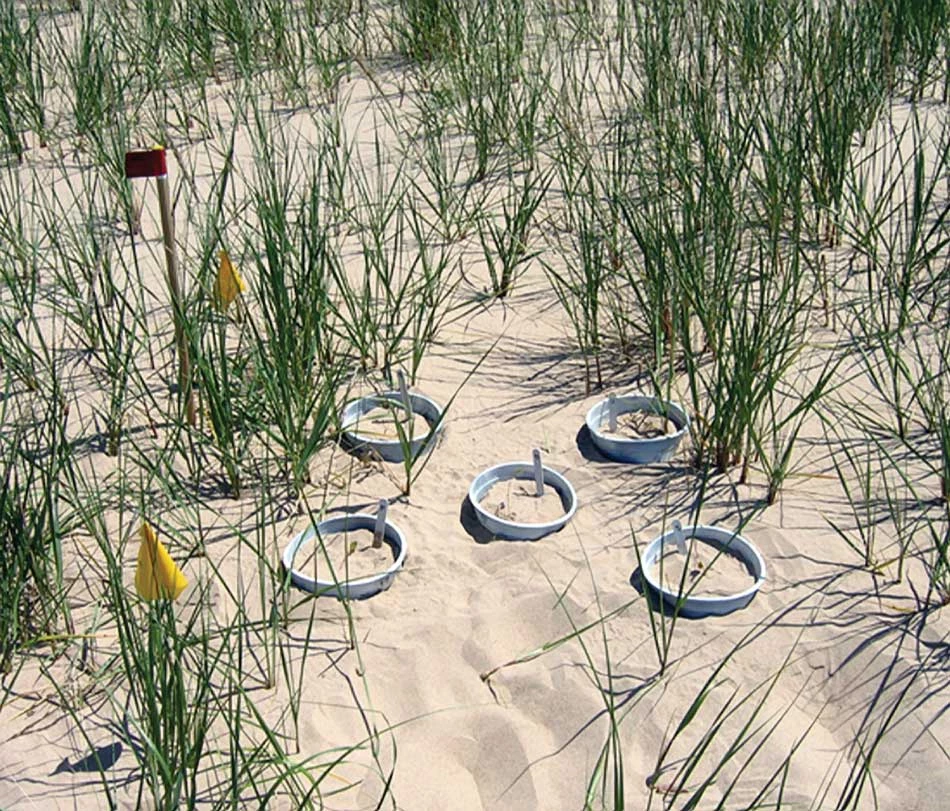
Courtesy of Jo Ann Dollard
Data collection
We recorded plant survival and stem length at monthly intervals through October 2008. We measured percentage of open canopy for each 1 m2 (11 ft2) quadrat during late summer of 2008. In addition, we recorded slope, aspect, and distance to the lake for each site. In spring of 2009, we took measurements on each erosion pin, recording sand accumulation and erosion.
From June to October, we measured percentage of soil moisture once a week in the center of each quadrat using time domain reflectometry (Mini Trase instrument). We installed four rain gauges (one at West Site, one at Central Site, and two at East Site) and made recordings once a week from June to October.
Statistical analysis
Because beach pea survival is a binary event (plants either survive or do not), we used logistic regression with backward stepwise elimination to analyze the results of the experimental reintroduction. This method identified variables that best predicted beach pea survival. Backward stepwise elimination starts with all variables and omits one at a time to see what effect this has on the model to explain a particular test condition.
We evaluated six predictor variables: (1) no water/water, (2) percentage of open canopy, (3) distance to the lake, (4) foredune or blowout-type habitat, (5) plant size in June, and (6) rain in June. The logistic regression analysis identified the predictor variables that best predicted beach pea survival.
We also compared the average percentage of soil moisture among quadrats with and without supplemental watering using a nested blocked ANOVA (analysis of variation) with five blocks and two treatments (supplemental and no supplemental watering) nested within the seven sites. This analysis is used to test effects of supplemental watering.
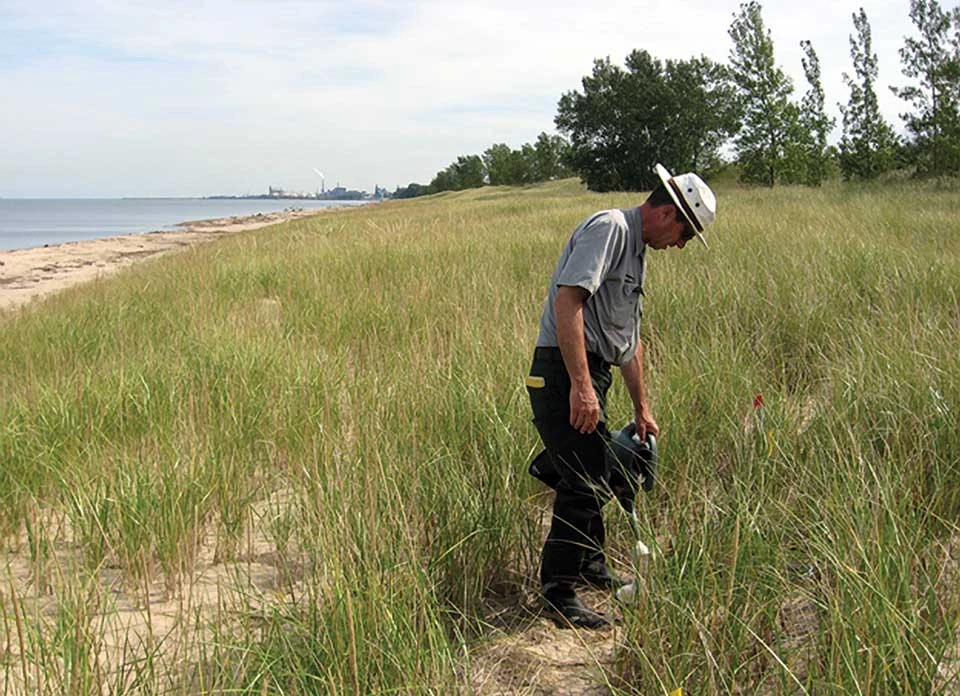
NPS Photo / Daniel Mason
Results
Fifty-six (16%) of the original 350 plants survived through the end of October 2008 (fig. 6). Most mortality occurred during the first few months after transplant, and the highest percentage of survival was in the quadrats that received supplemental watering. Accordingly, supplemental watering most strongly predicted high beach pea survival. Additional predictor variables associated with increased survival were large plant size in June, increased rainfall in June, location on foredunes, and location nearer to the lake.
The average percentage of soil moisture was higher in supplemental watering quadrats, as could be expected, than in control quadrats that relied on natural precipitation throughout the growing season. All rainfall totals were within 1 standard deviation of the July–October mean for 2004–2007 (669 mm ± 110 mm [26 in ± 4 in]), meaning that the rainfall was not abnormally high or low during this period. Sand accretion within the study sites ranged from 5 to 10 cm (2–4 in) inside silt fences, and 1 to 14 cm (0–6 in) outside of the silt fences.
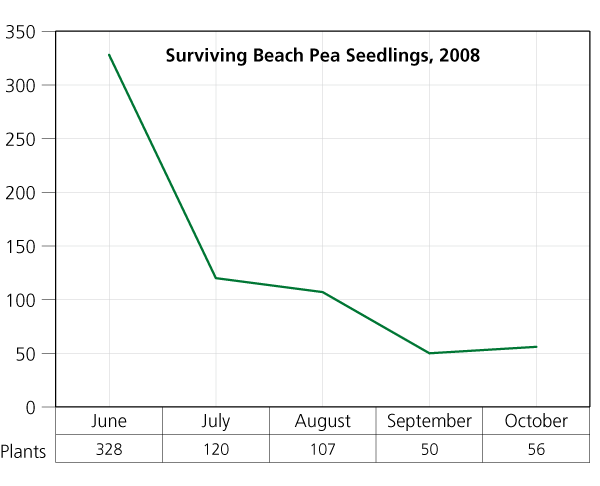
Population status
From the original 56 survivors of the 2008 experimental reintroduction, the population has increased tenfold. Based on the results of the reintroduction experiment, we adapted our management techniques to reflect improvements and began operations to transplant an additional 250 beach pea plants on average annually from 2009 to 2017. Our modified techniques included using larger initial transplants, planting in fall, and placing plants near nurse plants such as cottonwoods (Populus deltoides) (fig. 7). Nurse plants supply shade in the hot, dry conditions of the dunes and decrease transplant shock. Most of the transplants from 2009 to 2017 were to the West Site, though some went to East Site and small quantities went to other sites at Indiana Dunes National Lakeshore.
Because mature adult beach peas grown in containers have the highest survival rates, we now grow seedlings for 6–8 months before transplanting them to reintroduction sites in the fall (fig. 7). The location that originally had the highest survival rate (West Site) continues to be very productive. These plants are flowering, sending up new stems, and producing seeds. A large cohort of beach peas was planted at another foredune location (East Site) in the fall of 2015 and 2017. Many of the 2015 plantings at the East Site have survived and are producing new stems.
Discussions and lessons learned
We have a large collection of beach pea seeds collected from the nursery site and reintroduction sites, which can be used for further propagation. The best form of beach pea establishment is from seedlings grown for five to six months and then outplanted in fall. Once established at new sites these plants produce many new stems from underground rhizomes.
We did not observe many plants germinating from seeds at the parks we visited in the Great Lakes region. In the future, some of the seeds collected from the reintroduction and nursery sites can be planted along the park foredunes. If successful, this would be another method for establishing new populations.
Over the past few years the West Site has become vulnerable to more severe late fall and winter storms, and portions of these incipient foredunes have been eroded. To remediate this we have started planting beach pea farther back in secondary foredunes at West Site.
Another site in the eastern sector of the park is now showing promise, and we have supplemented existing plantings during the past three years. We have also tried plantings in later successional areas of the park, but these have not established well. Beach pea grows best in open sand areas, which have minimal plant competition, unlike conditions in late successional areas.
Survival of beach pea in some historical locations (e.g., Central Site) has been poor. Site disturbance from recreational activities, warm seasonal temperatures, and lack of sand replenishment because of structures such as jetties have likely impoverished these beach pea populations.
Transplanting of beach pea should continue at both the West Site and East Site, along with some other new foredune sites (e.g., possibly the Central Site).
With reintroduction increasingly being used as part of species recovery programs, measurable criteria for success need to be determined (Monks et al. 2012). Reintroduction success can be measured through abundance, extent, resilience, and persistence (Pavlik 1996). Several of these parameters are relevant in this reintroduction project, as follows. Beach pea at Indiana Dunes National Lakeshore is now abundant as measured by vegetative growth and fecundity, especially at the West Site. At least over the short term the population at West Site is self-sustaining, suggesting persistence, and seed dispersal may increase the species extent. Resilience, which measures genetic variation in a population, has not been measured.
Several studies could be implemented in the future to predict the viability of plantings. A population viability analysis that would include collection of demographic data could forecast the long-term survival of beach pea. Also, genetic analysis could compare the reference population to the reintroduction population to see how genetically diverse they are.
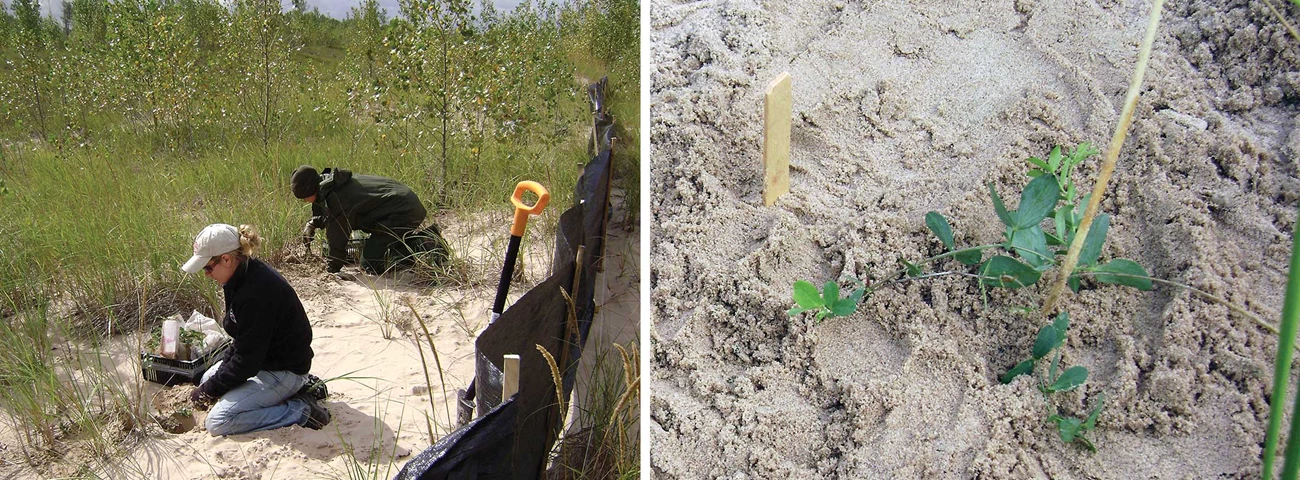
NPS Photos / Daniel Mason
Conclusion
The growth of the beach pea population at Indiana Dunes starting in 2008 and covering a 10-year span indicates a very successful reintroduction project (fig. 8). Plants have completed their life cycle; however, we have not noted any second-generation plants germinating from seed except in one instance at the park nursery site. We have established a large inventory of seeds, with some seeds being shared with other regional land managers. Additionally we have implemented effective management techniques for propagation, established best time for planting, and developed effective follow-up care methods.
We still find it difficult to ascertain whether or not the population is self-sustaining; continued population monitoring is needed to verify population growth. We recommend continued fall planting in the existing sites (West and East), finding alternate sites for new populations, and conducting annual observation/monitoring of sites.
Because microsites for rare plants continue to be altered by various disturbances, plant reintroduction work remains an important component in the National Park Service’s long-term conservation efforts for endangered plants.
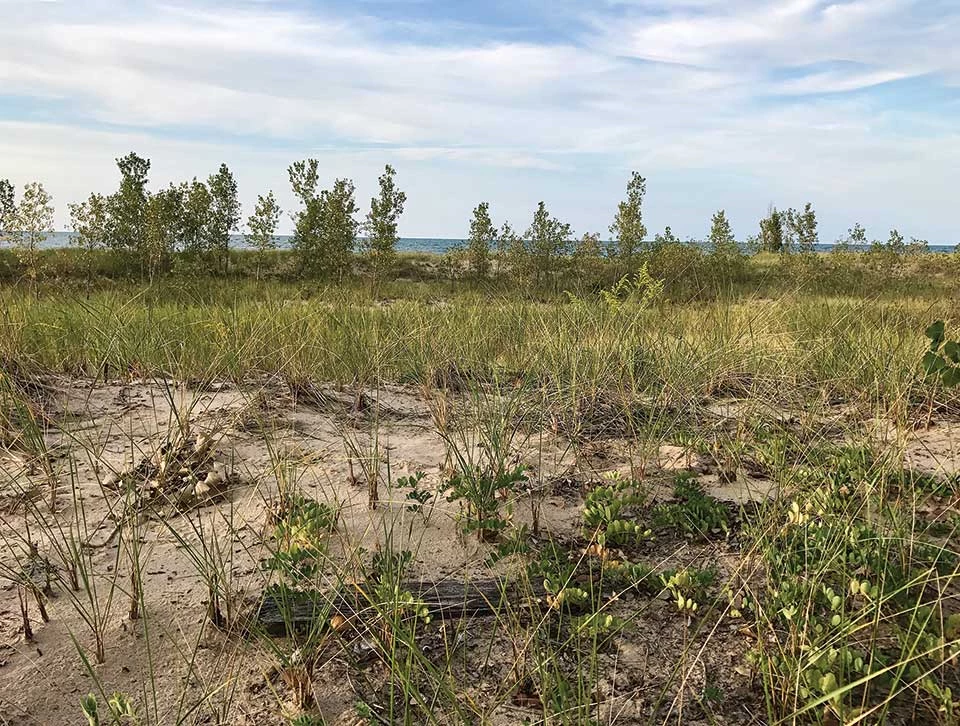
Photo courtesy of Jo Ann Dollard
References
Brightmore, D., and P. H. F. White. 1963. Lathyrus japonicus Willd. (L. maritimus Bigel). Journal of Ecology 51:795–801.
Dollard, J., and M. E. Carrington. December 2013. Experimental reintroduction of beach pea (Lathyrus japonicus) to the Indiana Dunes National Lakeshore. Ecological Restoration 31(4):368–377. doi:10.3368/er.31.4.368.
Hatfield, J. S., K. E. Myrick, M. A. Huston, F. W. Weekerly, and M. C. Green. May 2013. Vascular plant and vertebrate species richness in national parks of the eastern United States. Natural Resource Technical Report NPS/NCR/NCRO/NRTR–2013/002. US Department of the Interior, National Park Service, National Capital Region, Center for Urban Ecology, Washington, DC, USA.
Monks, L., D. Coats, T. Bell, and M. Bowles. 2012. Determining success criteria for reintroductions of threatened long-lived plants. Pages 189–208 in J. Maschinski and K. E. Haskins, editors. Plant reintroduction in a changing climate: Promises and perils. Island Press, Washington, DC, USA.
Pavlik, B. M. 1996. Defining and measuring success. Pages 127–155 in D. A. Falk, C. I. Millar, and M. Olwell, editors. Restoring diversity: Strategies for reintroduction of endangered plants. Island Press, Washington, DC, USA.
Acknowledgments
I would especially like to thank Dr. Daniel Mason, botanist at Indiana Dunes National Lakeshore, for all his support and help with funding, and all other staff who assisted in the project. I would also like to thank Dr. Mary Carrington, my advisor at Governors State University, for her support and guidance throughout the experimental reintroduction, the topic of my graduate thesis.
About the author
John J. Dollard, Jr., is a biological technician at Everglades National Park, Florida. He was a biological technician at Indiana Dunes National Lakeshore from 2004 to 2016. He is interested in plant conservation, coastal dune restoration, nursery growing, and wetland plant restoration in both temperate and subtropical climates. He can be reached at (305) 242-7894.
